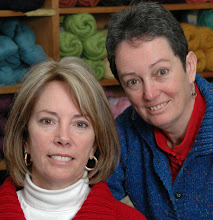Let's jazz up a knit-in-the-round stockinette sweater by adding a Cable panel. There are many stitch dictionaries to check out various cables.
Here are a couple of things to consider before working in-the-round with a cable pattern:
1. Most stitch dictionaries are written for flat knitting. There is a right side row where the cable crossing action is and a wrong side row worked back in knits and purls which amounts to "knit the knits and purl the purls".
2. The symbols used in charts are meant to convey what the pattern will look like on the Right Side of the work. This is a bonus to in-the-round knitting since you are always looking at the Right Side.
A Simple Rope Cable written for flat knitting.
Worked Flat
Row 1, 5 & 7: (RS) P2, K4, P2.
Rows 2, 4, 6 & 8: (WS) K2, P4, K2. (You can see the chart is awkward to read on the wrong side rows. "-" is a knit stitch and the white box is now a purl stitch.)
Row 3: P2, 2x2cross right, P2.
Worked in-the-round (all rounds read from Right to Left)
Rounds 1, 2, 4, 5, 6, 7 & 8: P2, K4, P2.
Round 3: P2, 2x2cross right, P2.
How easy is that. The in-the-round version has every round exactly the same, except for the cable cross Round 3. You can see how the pattern is going to look on your sweater with those purl stitches at the side. Your knitting will look exactly like the chart.
3. Cables pull in your fabric. If you are going to do your own designing and place a cable in a stockinette fabric garment you need to compensate for the pull-in or your garment will end up smaller than you want and with a ruffle effect at the top of a panel of cables and again at the bottom.
The rule is to increase 1 stitch for every 3 sts of a cable. This cable is a crossing of 2 over 2, total of 4 sts. I would increase 2 sts for this cable to compensate for the pull-in.
Now, when to work the increases and where?
You have to work the increases before the first cable crossing takes place*. This cable crossing is close to the beginning so I would work the increases as follows:
1. You can work 2 increases in the knit round before you begin your cable panel. Say you are placing this cable down the centre front of your sweater, over the centre 6 sts work K2, M1(make one stitch), K2, M1, K2. Now you have 8 centre stitches and on the next round you can begin with Round 1 of the cable panel.
2. You can work the 2 increases into the first round of the Cable Panel itself. This is what I would do. If you are working this cable down the centre front of your garment, work to the centre 6 sts, then I might work P2, M1(make one stitch), K2, M1, P2. Now I have 8 sts and Round 1 completed.
M1: With left needle lift the horizontal bar between the stitch just knit and the next stitch, from front to back, knit into the back of the resulting loop.
*If the first cable crossing is several rounds down the panel you can work the increases in the round before the first crossing takes place.
When you are finished working the desired length for your Cable panel, you have to decrease away the added stitches to get back to your original number of stitches. For this cable decrease 2 sts evenly across the panel so it's back to 6 sts again.
Next: Cables from the Top Down.
Stay tuned,
Deb
Wednesday, 22 February 2017
Subscribe to:
Post Comments (Atom)




makes total sense. never knew that about the increase for allowance.
ReplyDeletethanks.
t_a